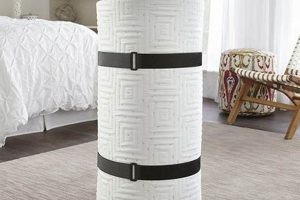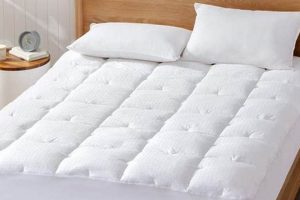A cushioning layer designed to be placed atop a mattress, intending to enhance comfort and provide pressure relief, is frequently employed to alleviate discomfort experienced in the shoulder region. These products modify the surface characteristics of the underlying mattress, potentially reducing pressure points that contribute to pain. An example would be a memory foam addition applied to a firm mattress, softening the sleeping surface and conforming to the body’s contours.
The selection and use of these comfort layers can be significant in improving sleep quality and reducing musculoskeletal discomfort. Historical applications have demonstrated their utility in adapting existing mattresses to meet evolving comfort needs or address specific physical ailments. The benefit lies in their ability to distribute body weight more evenly, thereby minimizing stress on sensitive areas like the shoulder joint, and contributing to a more restful sleep experience.
The subsequent sections will delve into various materials and constructions available, offering guidance on selecting an appropriate product, and outlining key considerations for optimizing its use to address shoulder-related pain. Specific materials, construction types, thickness, and density all contribute to the potential effectiveness of the product.
Guidance on Selecting a Mattress Topper for Shoulder Pain
The selection of an appropriate product requires careful consideration of various factors to maximize its effectiveness in reducing discomfort. The following guidelines offer practical advice for informed decision-making.
Tip 1: Material Selection: Opt for materials known for pressure-relieving properties, such as memory foam or latex. Memory foam conforms to the body’s contours, distributing weight and minimizing pressure points. Latex offers a more responsive feel with similar pressure relief.
Tip 2: Density Considerations: Higher-density materials generally provide greater support and longevity. However, individuals should balance density with personal preference for firmness. A density that is too high may feel overly firm.
Tip 3: Thickness Assessment: A sufficient thickness is necessary to provide adequate cushioning. Generally, a minimum of 2-3 inches is recommended for pressure relief. Thicker options may be suitable for individuals with more pronounced shoulder pain.
Tip 4: Firmness Level: Select a firmness level that complements the existing mattress. If the mattress is already soft, a medium-firm option might provide better support. Conversely, a softer option may be preferable for a firmer mattress.
Tip 5: Construction Type: Consider the construction type. Some products feature zoned construction with varying densities in different areas to provide targeted support. This may be beneficial for addressing specific pressure points in the shoulder region.
Tip 6: Mattress Compatibility: Ensure the chosen product is compatible with the existing mattress size and type. The depth of the mattress and presence of features like pillow tops may influence the selection of an appropriate product.
Tip 7: Consider Certifications: Look for certifications that indicate the product has been tested for harmful substances. Certifications such as CertiPUR-US can provide assurance of product quality and safety.
Adherence to these guidelines can significantly improve the likelihood of selecting a product that effectively addresses shoulder-related pain and enhances sleep quality. Focusing on material, density, thickness, firmness, construction and certification are all vital to choosing the right fit.
The subsequent section provides a summary of other alternative options to consider.
1. Material Composition
The material composition of a mattress topper significantly influences its effectiveness in alleviating shoulder pain. Different materials offer varying levels of support, pressure relief, and temperature regulation, directly impacting comfort and pain management.
- Memory Foam
Memory foam is known for its viscoelastic properties, conforming to the body’s shape and distributing weight evenly. This reduces pressure points that can exacerbate shoulder pain. High-density memory foam offers greater support and durability, while lower-density options provide a softer feel. Variations include open-cell memory foam, designed to improve airflow and reduce heat retention.
- Latex
Latex, derived from rubber trees, provides a responsive and resilient support. It conforms to the body, offering pressure relief similar to memory foam, but with a more buoyant feel. Natural latex is hypoallergenic and breathable, making it a suitable option for individuals with sensitivities. Synthetic latex provides a cost-effective alternative, though it may lack some of the benefits of natural latex.
- Down and Feather
Down and feather toppers offer a soft and plush surface, but provide minimal support for shoulder pain. While they enhance comfort, they may not adequately distribute weight or alleviate pressure points. These options are more suited for individuals seeking enhanced cushioning rather than targeted pain relief.
- Polyester Fiberfill
Polyester fiberfill toppers are a budget-friendly option, offering a degree of cushioning. However, they tend to flatten over time and provide less consistent support compared to memory foam or latex. While they can improve the overall comfort of a mattress, their effectiveness in reducing shoulder pain is limited.
The selection of material is therefore a crucial determinant of the effectiveness of a mattress topper in addressing shoulder pain. Memory foam and latex are generally preferred for their pressure-relieving properties, while down and feather or polyester fiberfill options may offer enhanced comfort without providing targeted pain relief. The material’s density and construction also contribute to the overall support and longevity of the product, influencing its long-term effectiveness.
2. Density Level
Density level, measured in pounds per cubic foot (PCF), is a crucial determinant of a mattress topper’s performance in mitigating shoulder pain. It directly affects the topper’s ability to provide support, pressure relief, and durability. Selecting an appropriate density level is essential for optimizing the therapeutic benefits of the product.
- Support and Spinal Alignment
Higher-density materials offer greater support, preventing excessive sinking and promoting proper spinal alignment. This is particularly important for individuals experiencing shoulder pain, as maintaining a neutral spine reduces stress on the shoulder joint. A density that is too low may result
in inadequate support, exacerbating discomfort. - Pressure Relief and Contouring
While support is essential, the ability to conform to the body’s contours and distribute weight is equally important. Moderate to high-density materials, such as memory foam and latex, excel in pressure relief. They cradle the shoulder, reducing pressure points that contribute to pain. Lower-density materials may not offer sufficient contouring, resulting in localized pressure.
- Durability and Longevity
Density is directly correlated with durability. Higher-density materials are more resistant to compression and degradation, maintaining their support and pressure-relieving properties over time. Lower-density materials tend to break down more quickly, requiring more frequent replacement. This factor is particularly relevant for individuals who use the topper regularly.
- Temperature Sensitivity
The density of memory foam can influence its temperature sensitivity. Higher-density memory foam may retain more heat compared to lower-density options or latex. Individuals who tend to sleep hot may prefer lower-density memory foam or latex, which offers better breathability.
The selection of an appropriate density level requires careful consideration of individual needs and preferences. Factors such as body weight, sleeping position, and sensitivity to temperature should be taken into account. A balance between support, pressure relief, and durability is essential for maximizing the effectiveness of a mattress topper in alleviating shoulder pain. Choosing a memory foam, latex or other material with correct density level will enhance sleep quality and comfort.
3. Thickness Options
The thickness of a mattress topper is a critical factor in determining its effectiveness in alleviating shoulder pain. Variations in thickness directly influence the level of cushioning and support provided, impacting pressure distribution and spinal alignment. The selection of an appropriate thickness is thus paramount to achieving optimal pain relief.
- Pressure Redistribution
Thicker mattress toppers generally provide more effective pressure redistribution. Individuals experiencing shoulder pain benefit from a topper that can minimize pressure points on the affected area. A thicker topper conforms more closely to the body’s contours, distributing weight evenly and reducing stress on the shoulder joint. For instance, a 4-inch topper may offer significantly greater pressure relief compared to a 2-inch option, particularly for side sleepers.
- Support and Spinal Alignment
Thickness contributes to the overall support provided by the topper. Adequate thickness prevents excessive sinking into the mattress, maintaining proper spinal alignment. This is crucial for preventing further aggravation of shoulder pain. A topper that is too thin may not provide sufficient support, resulting in spinal misalignment and increased discomfort. A properly chosen thickness ensures the spine remains in a neutral position during sleep.
- Mattress Condition and Longevity
The thickness of a mattress topper can compensate for the condition of the underlying mattress. A thicker topper can revitalize an older, less supportive mattress, providing enhanced comfort and pain relief. Furthermore, a thicker topper can protect the mattress from wear and tear, extending its lifespan. However, a very thick topper may alter the feel of a new mattress, potentially negating its intended support characteristics.
- Material Compression and Durability
Thicker toppers are generally more resistant to compression and degradation over time. The additional material provides greater resilience, maintaining its support and pressure-relieving properties for a longer duration. Thinner toppers are more susceptible to compression, potentially losing their effectiveness more quickly. Selecting a thicker option can thus result in a more durable and cost-effective solution in the long term.
In summary, the thickness options available in mattress toppers are integrally linked to their capacity to alleviate shoulder pain. Factors such as pressure redistribution, support for spinal alignment, mattress condition, and material durability all contribute to the overall effectiveness of the product. Selecting an appropriate thickness, typically ranging from 2 to 4 inches, is essential for optimizing comfort and pain relief. Ultimately, the best choice depends on individual needs and preferences, as well as the condition and characteristics of the underlying mattress.
4. Support Characteristics
Support characteristics are paramount when evaluating the suitability of a mattress topper for mitigating shoulder pain. The capacity of the topper to maintain proper spinal alignment and distribute body weight directly influences the degree of pressure relief experienced in the shoulder region. Therefore, a comprehensive understanding of these characteristics is crucial for informed decision-making.
- Firmness Level and Spinal Alignment
The firmness level of a mattress topper dictates its ability to maintain spinal alignment. A topper that is too soft may allow the spine to sag, exacerbating shoulder pain. Conversely, a topper that is too firm may not conform adequately to the body’s contours, resulting in pressure points. The ideal firmness level depends on individual body weight, sleeping position, and the firmness of the underlying mattress. For example, a side sleeper with a softer mattress may benefit from a medium-firm topper to prevent spinal misalignment.
- Edge Support and Sleep Surface Utilization
Edge support refers to the stability provided around the perimeter of the topper. Adequate edge support allows for full utilization of the sleep surface without the sensation of rolling off. This is particularly important for individuals who share a bed or tend to sleep near the edge. Without sufficient edge support, pressure may be unevenly distributed, potentially contributing to shoulder discomfort. For example, if the edges collapse, the sleeper may unconsciously tense shoulder muscles to maintain position, leading to pain.
- Zoned Support and Targeted Pressure Relief
Zoned support refers to variations in firmness across different areas of the topper. Some toppers feature firmer support in the lumbar region and softer support in the shoulder region, providing targeted pressure relief. This construction is specifically designed to address pressure points in sensitive areas. An example would be a topper with enhanced shoulder cradling to minimize compression of the shoulder joint during sleep.
- Material Resilience and Long-Term Support
Material resilience refers to the ability of the topper to return to its original shape after compression. High-resilience materials, such as latex, maintain their support characteristics over time. Low-resilience materials, such as some types of memory foam, may gradually lose their support, requiring more frequent replacement. The long-term support provided by the topper directly impacts its effectiveness in alleviating shoulder pain. For example, a topper that loses its shape within a year may no longer provide adequate pressure reli
ef.
In conclusion, the support characteristics of a mattress topper are intrinsically linked to its ability to address shoulder pain. Factors such as firmness level, edge support, zoned support, and material resilience all contribute to the overall effectiveness of the product. Careful consideration of these characteristics is essential for selecting a topper that provides optimal support, pressure relief, and spinal alignment, thereby promoting restful sleep and reducing shoulder discomfort.
5. Pressure Relief
Pressure relief is a fundamental consideration in the selection of a mattress topper intended for individuals experiencing shoulder pain. The ability of the topper to redistribute body weight and minimize concentrated pressure points directly influences the degree of discomfort experienced during sleep. The following facets explore key aspects of this relationship.
- Material Conformability
The material’s capacity to conform to the body’s contours is paramount. Materials like memory foam and latex exhibit viscoelastic properties, enabling them to mold to the shape of the shoulder, thereby distributing weight over a larger surface area. This reduces localized pressure that can exacerbate pain. A topper that fails to conform adequately may create or worsen pressure points, leading to increased discomfort and disturbed sleep.
- Thickness and Immersion
The thickness of the topper influences the degree of immersion, which is the extent to which the body sinks into the material. Greater thickness generally corresponds to greater immersion and enhanced pressure relief. Sufficient immersion allows the shoulder to settle into the topper, minimizing compression of the joint. A topper that is too thin may not provide adequate immersion, resulting in persistent pressure on the shoulder.
- Surface Tension Reduction
A topper’s ability to reduce surface tension is critical in minimizing pressure on the shoulder. Surface tension refers to the resistance of the sleep surface to deformation. A topper with low surface tension conforms readily to the body’s shape, reducing the force exerted on pressure points. Materials like gel-infused memory foam are designed to minimize surface tension, promoting greater pressure relief.
- Dynamic Weight Distribution
Pressure relief is not solely a static phenomenon; it also involves dynamic weight distribution during movement. A topper that allows for smooth and gradual weight shifts reduces the likelihood of sudden pressure spikes that can trigger pain. Materials with high resilience, such as latex, respond quickly to changes in pressure, promoting dynamic weight distribution and minimizing discomfort. The topper should accommodate shifts in sleeping position without creating new pressure points on the shoulder.
These facets underscore the significance of pressure relief in the context of a mattress topper designed to alleviate shoulder pain. Material conformability, thickness, surface tension reduction, and dynamic weight distribution collectively determine the topper’s effectiveness in minimizing pressure points and promoting comfortable sleep. Selecting a topper that excels in these areas is crucial for individuals seeking relief from shoulder-related discomfort.
Frequently Asked Questions
The following section addresses common inquiries regarding the use of mattress toppers for alleviating shoulder pain. It aims to provide clear, concise answers based on current understanding.
Question 1: What types of mattress toppers are most effective for shoulder pain?
Memory foam and latex toppers are generally considered most effective. Memory foam conforms to the body, distributing weight and reducing pressure points. Latex offers similar benefits with a more responsive feel. The effectiveness of each depends on individual preferences and specific needs.
Question 2: How thick should a mattress topper be to alleviate shoulder pain?
A thickness of 2 to 4 inches is generally recommended. This range provides adequate cushioning and support to relieve pressure on the shoulder. The optimal thickness may vary depending on body weight and the firmness of the existing mattress.
Question 3: Can a mattress topper correct a poor mattress for shoulder pain?
A mattress topper can improve comfort and pressure relief on a subpar mattress. However, it is not a substitute for a supportive mattress. If the underlying mattress lacks adequate support, a topper may only provide limited relief.
Question 4: How does topper density affect its performance in reducing shoulder pain?
Denser materials generally offer greater support and durability. Higher-density memory foam and latex are more resistant to compression and maintain their shape over time. However, density should be balanced with personal comfort preferences.
Question 5: Are there any potential drawbacks to using a mattress topper for shoulder pain?
Potential drawbacks include heat retention with some memory foam toppers, and the potential for the topper to shift or slip on the mattress. Selecting a topper with cooling properties or using a mattress protector can mitigate these issues.
Question 6: How long does a mattress topper typically last?
The lifespan of a mattress topper depends on the material, density, and usage. High-quality memory foam and latex toppers can last for several years. Regular cleaning and proper maintenance can extend their lifespan.
In summary, selecting an appropriate mattress topper requires careful consideration of material, thickness, density, and support characteristics. While a topper can provide significant relief from shoulder pain, it is not a replacement for a supportive mattress or medical treatment.
The next section offers a summary of other alternative options to consider.
Conclusion
The preceding discussion underscores the importance of selecting an appropriate mattress topper for shoulder pain. It highlights key aspects such as material composition, density level, thickness, support characteristics, and pressure relief, emphasizing how these factors contribute to minimizing discomfort and promoting restful sleep. Addressing the root cause of pain and finding the right solution is important.
It is thus recommended that individuals carefully evaluate their specific needs and preferences before making a purchase. Consulting with healthcare professionals may also be beneficial in determining the most suitable option. Ultimately, the selection of an appropriate mattress topper for shoulder pain can significantly enhance sleep quality and reduce the burden of chronic pain, it needs to be approached with informed decision-making.


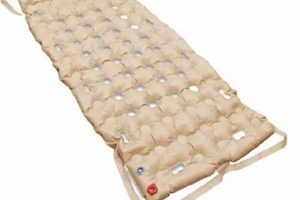
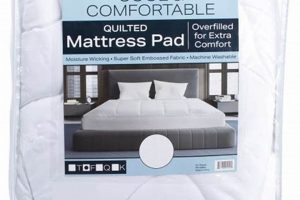
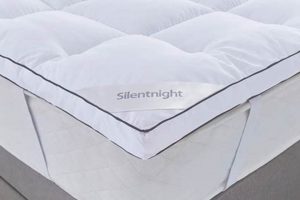
![Best Mattress Firm Mattress Topper: [Guide] Your Sleep Upgrade! Organic & Natural Mattress Buyer’s Guide: Non-Toxic Sleep Solutions Best Mattress Firm Mattress Topper: [Guide] Your Sleep Upgrade! | Organic & Natural Mattress Buyer’s Guide: Non-Toxic Sleep Solutions](https://mattressworldpa.com/wp-content/uploads/2025/07/th-5922-300x200.jpg)
